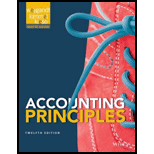
Concept explainers
(a)
(1)
The process of recording:
The process of accounting can be defined as a series of activities, which are initiated at the opening of a transaction and accomplished with the closing of books. The series of activities involves identification, recording, and communication. The first step in the recording process is analyzing each transaction in terms of its effects on the accounts. The accounts are identified for debit and credit. The second step in the recording process is to record the information related to the transaction in a journal. The last step in the process is to post the information recorded in the journal to the respective account in the ledger.
To determine: The primary source document for recording cash sales
(2)
The primary source document for recording credit sales
(b)
A journal entry refers to the logging of a transaction into accounting journal items. The journal entry consists of different recordings, each of which is a debit or credit. The first step in the accounting process is analyzing the transactions and recording them as journal entries.
Procedure for debiting and crediting an account:
- Increase in assets account, increase in expenses account, and decrease in liabilities account should be debited.
- Decrease in assets account, increase in revenue account, and increase in liabilities account should be credited.
All transactions affect the
To prepare: The journal entries for cash sales.
Want to see the full answer?
Check out a sample textbook solution
Chapter 5 Solutions
Accounting Principles - Standalone book
- I need help with this financial accounting problem using accurate calculation methods.arrow_forwardNonearrow_forwardDakota Manufacturing uses a standard cost system in which manufacturing overhead is applied to units of product on the basis of standard machine hours. During April, the company used a denominator activity of 40,000 machine hours in computing its predetermined overhead rate. However, 52,000 standard machine hours were allowed for the month's actual production. If the fixed manufacturing overhead volume variance for April was $9,000 unfavorable, then the total budgeted fixed manufacturing overhead cost for the month was $_. HELParrow_forward
- Gabbana Manufacturing estimated that machine hours for the year would be 30,000 hours and overhead (all fixed) would be $150,000. Gabbana applies its overhead on the basis of machine hours. During the year, all overhead costs were exactly as planned ($150,000). There was $12,000 in over-applied overhead. How many machine-hours were worked during the period?arrow_forwardSub.General Accountarrow_forwardGabbana Manufacturing estimated that machine hours for the year would be 30,000 hours and overhead (all fixed) would be $150,000. Gabbana applies its overhead on the basis of machine hours. During the year, all overhead costs were exactly as planned ($150,000). There was $12,000 in over-applied overhead. How many machine-hours were worked during the period? Need helparrow_forward
- Tropical Furnishings, Inc. had net cash from operating activities of $178,000. It paid $140,000 to buy new manufacturing equipment by signing a $110,000 note and paying the balance. Net cash from (or used for) investing activities for the period was _.arrow_forwardHi expert please given correct answer with accounting questionarrow_forwardI need guidance with this financial accounting problem using the right financial principles.arrow_forward

 AccountingAccountingISBN:9781337272094Author:WARREN, Carl S., Reeve, James M., Duchac, Jonathan E.Publisher:Cengage Learning,
AccountingAccountingISBN:9781337272094Author:WARREN, Carl S., Reeve, James M., Duchac, Jonathan E.Publisher:Cengage Learning, Accounting Information SystemsAccountingISBN:9781337619202Author:Hall, James A.Publisher:Cengage Learning,
Accounting Information SystemsAccountingISBN:9781337619202Author:Hall, James A.Publisher:Cengage Learning, Horngren's Cost Accounting: A Managerial Emphasis...AccountingISBN:9780134475585Author:Srikant M. Datar, Madhav V. RajanPublisher:PEARSON
Horngren's Cost Accounting: A Managerial Emphasis...AccountingISBN:9780134475585Author:Srikant M. Datar, Madhav V. RajanPublisher:PEARSON Intermediate AccountingAccountingISBN:9781259722660Author:J. David Spiceland, Mark W. Nelson, Wayne M ThomasPublisher:McGraw-Hill Education
Intermediate AccountingAccountingISBN:9781259722660Author:J. David Spiceland, Mark W. Nelson, Wayne M ThomasPublisher:McGraw-Hill Education Financial and Managerial AccountingAccountingISBN:9781259726705Author:John J Wild, Ken W. Shaw, Barbara Chiappetta Fundamental Accounting PrinciplesPublisher:McGraw-Hill Education
Financial and Managerial AccountingAccountingISBN:9781259726705Author:John J Wild, Ken W. Shaw, Barbara Chiappetta Fundamental Accounting PrinciplesPublisher:McGraw-Hill Education





